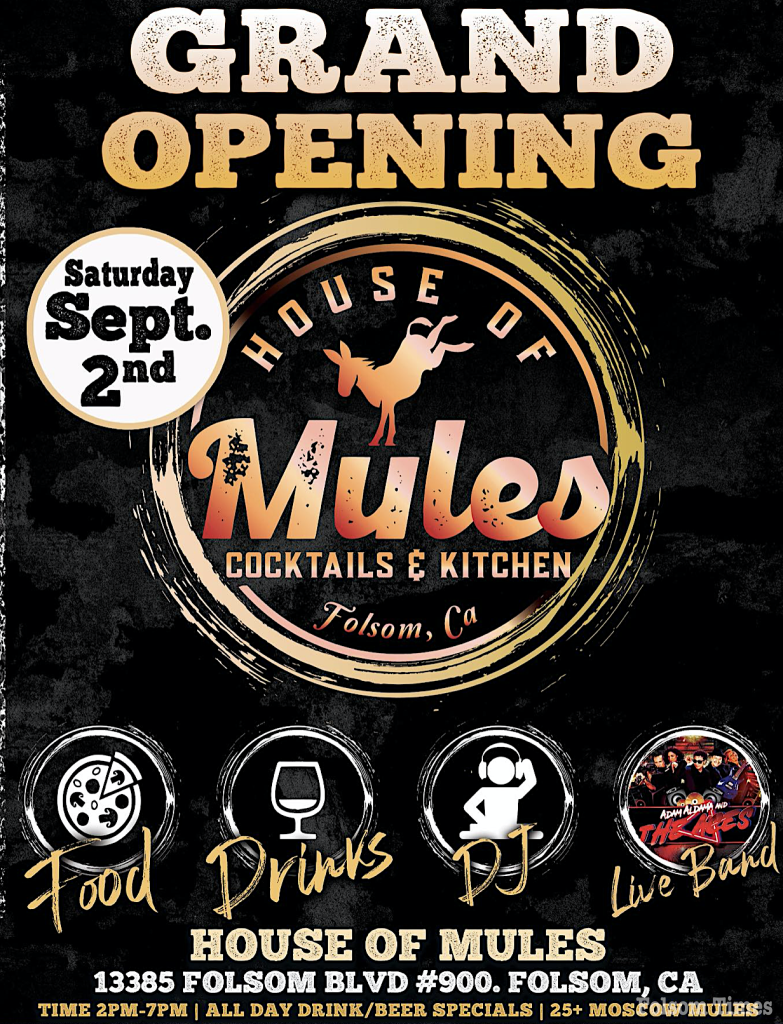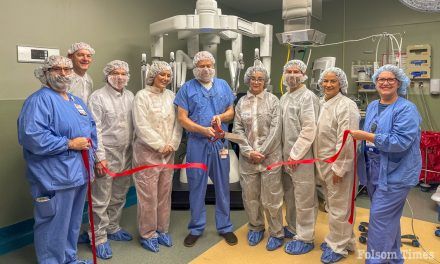It’s been a journey to get here since late last year, but the owners of a unique new place for food and spirits have announced they will open their doors this weekend. Vodka and copper cup lovers get ready, Folsom’s House of Mules Cocktails and Kitchen is set to open this Saturday, Sept. 2.
Folsom’s House of Mules is an eatery and bar that is themed around and will specialize in Moscow Mule cocktails. The unique establishment is at 13385 Folsom Boulevard in the Folsom Creek retail center where it fills a completely renovated 3,444 square foot space once occupied by La Bou Bakery, which closed its doors over a year ago.
House of Mules comes to Folsom thanks to the vision and hard work of business partners Ravi Ram and Lovey Sidhu. The duo has long been behind the well-known Kick’ Mule Sports Bar in West Sacramento, which is a similar concept to that of the new Folsom restaurant that will have a big focus on fresh eats, in addition to a menagerie of those beloved “Mules.”
According to Sidho “fresh” is the name of the game at House of Mules, as the company will not utilize any on site freezers for food products. Everything will be made fresh on daily basis. While the two operations will be completely separate, Sidhu cited in a previous Folsom Times article earlier this year that the Folsom restaurant will be similar to the West Sacramento Kick’n Mule when it comes to its menu that will feature a variety of appetizers, burgers, pastas and rotational specials catering to all ages.
Along with the many tasty eats, an impressive selection of its signature cocktails will grace the menu. For those that aren’t aware, Moscow Mules are traditionally concocted of ginger beer, vodka and lime juice and have been traditionally served in copper mugs since it was born in 1941 in Manhattan from inside New York’s Chatham Hotel. A number of different spirits and flavorings are used to create a hoopla of different varieties when it comes House of Mules.
Additionally, they will offer a wide variety of mimosas, a longtime favorite when it comes to enjoying brunch.
“We are going to have a lot of mimosas for weekend brunch and will have a variation of over 25 different Moscow mules,” Sidhu previously shared.
House of Mules has yet to launch its live website or online menu,. Saturday’s grand opening hours will be from 11 a.m. until 11 p.m. with the live music scheduled to take place from 2 p.m until 7 p.m. according to their social media page and advertisement below. The event will include entertainment by a DJ and a live band and have plenty of food and drinks on the menu. At this time you can find House of Mules on both Facebook and Instragram.
The Moscow Mule: Fact about the famed cocktail
The Moscow Mule is one of the most popular, and most identifiable, cocktails in the world. It seems to be without borders when it comes to its global presence, but few people know much of its history and origins, which are detailed here below thanks to a little help from a blog entry courtesy of“Moscow Muled.”
What Exactly is a classic Moscow Mule?
Ask any professional mixologist and they’ll tell you that the most classic rendition of a Moscow Mule is a mix of vodka, the juice of a fresh lime, and ginger beer.
As with all classic cocktails, innovation eventually comes into play and new & “improved” versions are introduced, usually with the additions of flavored syrups, fresh herbs or different tonics. Search for Moscow Mule recipes today and you’ll be presented with an array of options, some nowhere near what the classic mix entails.
Another tradition when making a classic Moscow Mule is that it is customarily served in a copper mug. This is something rooted in the history and origins themselves, and the copper mug is what makes the Moscow Mule such a recognizable cocktail around the world.
Theories of history and origin
While there are numerous accounts of exactly how the Moscow Mule came to be, the underlying origins seem to remain unanimous in theory. You need to keep in mind that the Moscow Mule was created during a time before documenting food and beverages was an actual career. It’s thanks to oral traditions, between people who were there, that we have all of this information.
The following three tales give very different accounts of the unfolding of things, but somehow tie together seamlessly in the end.
The Sophie theory
The Moscow Mule origin has been questioned time and time again. One theory speaks of a woman named Sophie Berezinski, a Russian-born woman attempting to immigrate to the United States in 1941. You see, Sophie was moving continents with little to no possessions to her name other than 2,000 pure copper mugs.
Sophie’s father was apparently the owner and operator of the Moscow Copper Co. in Russia. Sophie had the bright idea of copper-made mugs, and designed the original version herself. Her father saw to it that Sophie’s design was stamped out in the factory, and 2,000 copies of her mug were made.
At this time, America was seen as the land of opportunity. Selling 2,000 copper mugs in Russia was not something that Sophie or her father were capable of doing. They decided that Sophie and her husband would travel to the USA with the 2,000 mugs, and would do whatever they could to see to it they were sold.
The land of opportunity proved less than fruitful, and, after a few months of sitting on the thousands of mugs, Sophie’s husband became ready to throw in the towel. He gave Sophie the ultimatum of either finding a buyer for the mugs, or throwing them out once and for all.
Not ready to abandon her goal, Sophie set out on foot and began walking door to door through Los Angeles. She approached every bar, lounge and restaurant she could find, in hopes she could convince an establishment owner to invest in some or all of the copper mugs.
It was on this day that Sophie wandered hopefully into the Cock ‘n’ Bull; a pub in Ocean Park, close to Santa Monica and Venice Beach…
The West Coast theory
While our protagonist, Sophie, is busy pondering ways of selling her copper mugs while in the United States, two more characters are having a rendezvous of their own in Los Angeles.
A man named Jack Morgan owned the aforementioned Cock ’n Bull pub in Ocean Park. It was his dream to give the world an authentic, American-made ginger beer, and he was drowning in product throughout 1941.
Another man, named John G. Martin, was the head at Heublein & Brothers. He had recently made the bold decision of purchasing an entire distillery, leaving him with an unfathomable surplus of vodka and nowhere to put it.
Conveniently, Jack and John were old friends, and found solace in sitting together inside of Jack’s pub, tossing back some cold ones and poking fun at one another’s seemingly failing business ventures. It just so happens that this is what they were doing the day that Sophie Berezinski came knocking on their door, looking to sell 2,000 mugs made of copper.
The Moscow Mule history can perhaps be traced back right to this moment of serendipity. One man with a surplus of ginger beer, one man with a surplus of vodka, and one woman with a plethora of copper mugs, all brought together under the roof of a conveniently well-stocked bar. Some would call it fate.
With the irony of all three surpluses not lost on them, the three got to work almost immediately. They spent the next few hours brainstorming a cocktail made using vodka, ginger beer and copper, and by the end of the day the Moscow Mule was born.
Between the fizz of the homemade ginger beer, the potency of the vodka, and the cooling properties of the copper, this cocktail became an instantly easy-sell. The trio added a tot of fresh lime juice for an additional punch, and it brought the drink to life.
This is where serving Moscow Mules incopper mugsbecomes rooted in the cocktail’s history. It is said that the Moscow Mule was first ever served to an actor named Broderick Crawford. After that, its popularity spread like wildfire.
There are some versions of this theory that don’t account for the existence of Sophie Berezinski at all. One historian recounts that it was actually Jack Morgan’s then girlfriend, Osalene Schmitt, who had simply inherited a business that manufactured copper goods. She would eventually design and make copper mugs of her own, filtering them into the bar and pub industries through the Cock ’n Bull.
Considering that the Moscow Mule cocktail managed to spread across America shortly after its initial creation, it would make sense that the duo had access to a local manufacturer of copper mugs, as opposed to just the 2,000 that Sophie tugged along in her luggage.
The big apple theory
Around the time when Sophie was settling into the United States with her impatient husband and 2,000 mugs of copper, a man named George Sinclair reports the Moscow Mule having actually been born on the other side of the country: in Manhattan, New York.
Sinclair is an author who discovered that a 1948 edition of the New York Herald Tribune refers to a new cocktail on the block; the Moscow Mule. This brings the true Moscow Mule origin into question.
This theory maintains the official birthplace of the Moscow Mule as being inside of New York’s Chatham Hotel. The year is still 1941, and Jack Morgan is still trying to sell his boatload of American ginger beer to anyone who will listen.
Jack is visiting New York with this prospect in mind. He is seated at the bar inside of the Chatham Hotel. John Martin, his close friend and owner of Heublein & Brothers, is with him. John Martin is still sitting on a surplus of vodka at this point, thanks to his recent investment in a distillery. They are joined by a third friend, a man named Rudolph Kunett.
Rudolph Kunett is the president of Pierre Smirnoff, the vodka division recently obtained by John Martin. The two spent some time pondering their spirit endeavor, and began joking about combining the vodka with their friend Jack’s homemade ginger beer.
They began instructing the hotel bartender to mix up the solution. They ordered lime juice and threw that in, too. Ice was added, and the Moscow Mule was born.
Of course this story neglects to account for how the Moscow Mule came to be traditionally served in copper mugs. If it is true that Osalene Schmitt inherited her copper factory around the same time, it would make sense that Jack Morgan might have later suggested they use her mugs as a serving vessel.
That being said, the name ‘Moscow Mule’ could be reason to believe that there was definitely a Russian origin somewhere in the mix. If Sophie Berezinski had indeed brought the mugs over, just as a mule might cart things from A to B, then it makes sense that the naming process would have led the three founders to ‘Moscow Mule’. Alternatively, it could simply be that the presence of vodka, which is a classically Russian spirit, was the reason for the use of the word ‘Moscow’ in the cocktail’s name.
It was in 2007 that a new theory emerged almost completely disproving the Big Apple theory. Jack Morgan’s head bartender, Wes Price, is quoted as saying that the creation of the Moscow Mule occurred for no reason other than that he was simply trying to get rid of unsold inventory in the cellar of the bar in Los Angeles.
Price claims that he was the one to mix the first Moscow Mule and serve it to the actor Broderick Crawford, thereafter seeing it spread like wildfire. “I just wanted to clean out the basement”, Price said.
All theories aside
Theories aside, there is no denying that the appeal of the Moscow Mule spread very quickly following its initial creation. This cocktail is now served around the world, from the deep of the west to the furthest east. Restaurants and bars in the south of Africa have also taken fondly to the classic version.
Navigating which theory is more likely to hold the true history and origin of the Moscow Mule becomes easier when one looks at the follow up actions of John Martin.
Motivated by the prospect of selling his own vodka, Martin took it upon himself to see that the Moscow Mule made a name for itself all across the United States, and the copper mugs helped him do this.
Shortly after the birth of the Moscow Mule, Martin set out from either LA or New York, slowly making his way from state to state and introducing bartenders along the way to this revolutionary mix.
He took copper mugs along with him, and after showing the bartenders how to mix the drink itself, he would photograph them on two slides of Polaroid film. One slide was for them to keep, the other was for him. He knew that the bartenders were likely to hang the image of themselves proudly posing with the very identifiable mug, and at very least this would spark interest in bar-goers viewing the image.
Slowly but surely, people began inquiring about the drink contained in the striking copper vessel, and bars around America were forced to add the Moscow Mule to their existing cocktail lists.
Fast forward almost 80 years and the Moscow Mule remains one of the most frequently ordered cocktails in the world.





